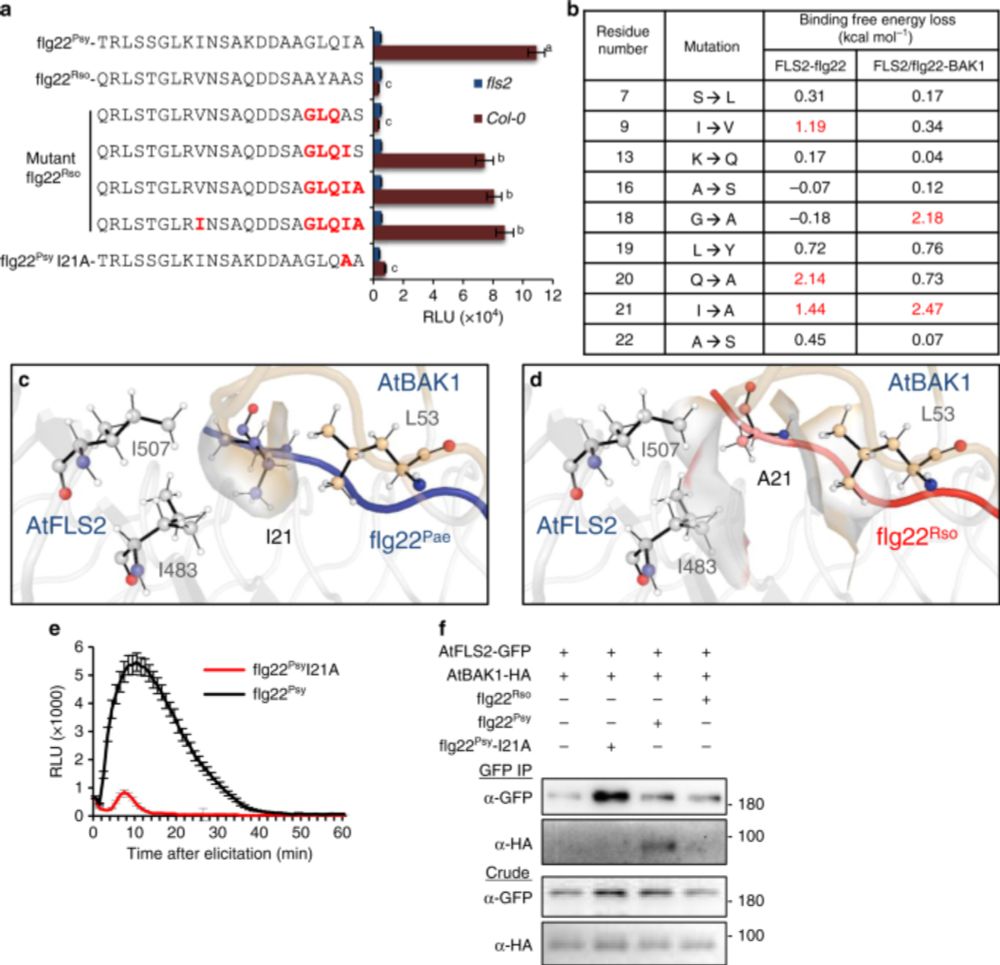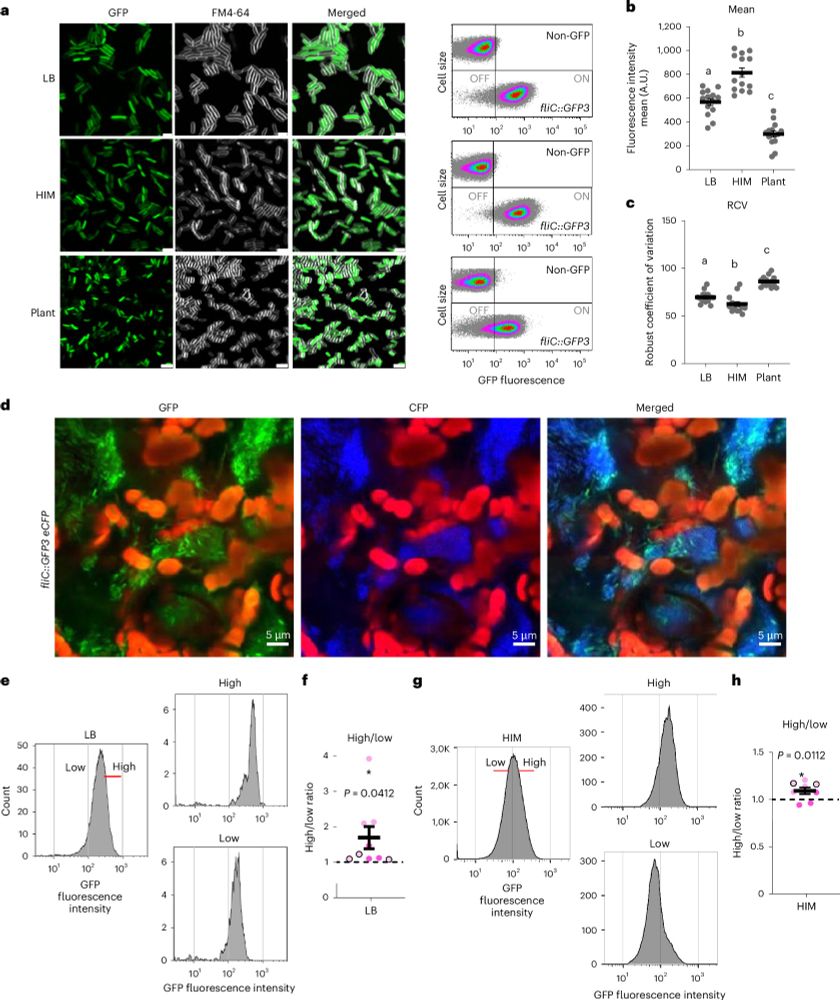
These phosphorylation sites seem to be important for RipBM contribution to virulence in tomato, reflecting an effector strategy to promote its own stability and contribute to bacterial virulence
02.09.2025 09:53 — 👍 1 🔁 0 💬 1 📌 0
However, RipBM is phosphorylated by SnRK-family proteins in plant cells and subsequently associates with plant 14-3-3 proteins, which prevent RipBM ubiquitination and degradation
02.09.2025 09:53 — 👍 0 🔁 0 💬 1 📌 0
RipBM is an unconventional type-III effector from Ralstonia, in the sense that it encodes a kinase domain, although, in our experience, kinase activity is not detectable. Sustained RipBM expression in eukaryotic cells leads to cell death, which seems to be a toxic effect of RipBM activity
02.09.2025 09:53 — 👍 1 🔁 0 💬 1 📌 0
My guess is it forms an “imperfect” complex that mediates a different type of recognition of flg22Rso and a subsequent activation that does engage all the usual downstream targets, but only some of them
31.07.2025 09:48 — 👍 2 🔁 1 💬 0 📌 0
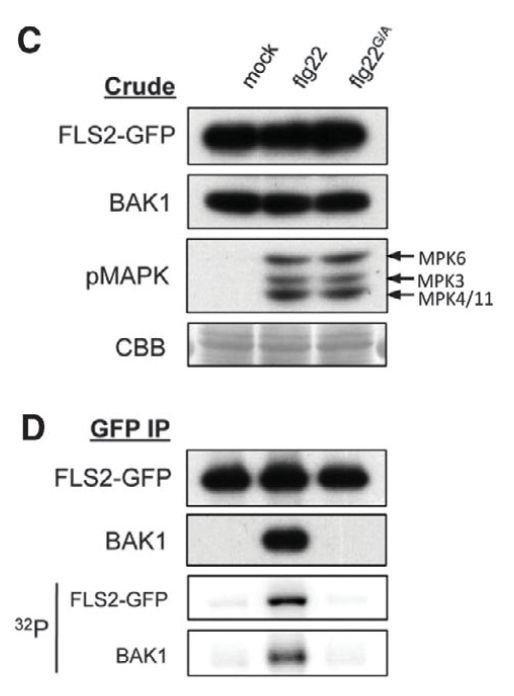

This reminds me the treatments with the flg22G/A mutant peptide we did in Sun et al, Science, 2013 (doi.org/10.1126/scie...). That mutation abolishes BAK1 interaction and activation, significantly reduces ROS, but does not affect MAPK activation
26.07.2025 03:49 — 👍 1 🔁 0 💬 0 📌 0
Hopefully, the information that heterologous PRR expression can confer novel PAMP recognition could provide new information for the design of synthetic immune receptors with expanded recognition of polymorphic pathogen elicitors
26.07.2025 02:21 — 👍 0 🔁 0 💬 0 📌 0
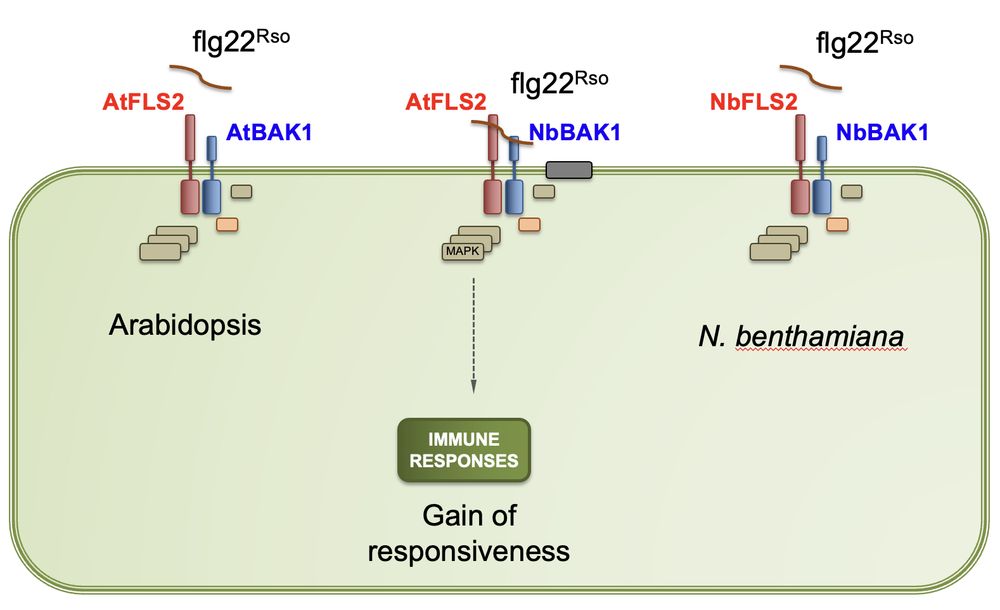
Long story short, it seems that AtFLS2, when expressed in N. benthamiana, associates with NbSERKs and mediate a “partial” complex activation that leads to some downstream responses (MAPK, gene expression), but not others (ROS). Eventually, this enhances disease resistance
26.07.2025 02:21 — 👍 1 🔁 0 💬 2 📌 0
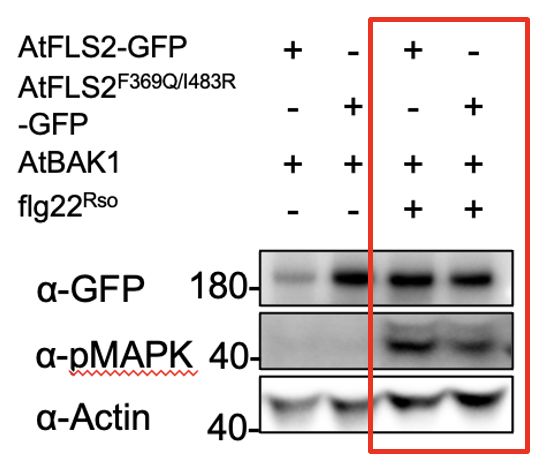
We did not see any gain of flg22Rso-triggered ROS burst, but…
there was MAPK activation. Surprisingly, what was supposed to be a “negative control”, even WT AtFLS2 expressed in N. benthamiana would confer MAPK activation upon flg22Rso treatment
26.07.2025 02:21 — 👍 0 🔁 0 💬 1 📌 0
Our latest article is now online!
@PlantBiotechnologyJournal
Expression of Arabidopsis FLS2 in N. benthamiana confers responsiveness to Ralstonia flg22 and activation of anti-bacterial immunity
doi.org/10.1111/pbi....
By Meng Li, Yujiao Chen, and Yali Wei
26.07.2025 02:21 — 👍 33 🔁 16 💬 5 📌 0
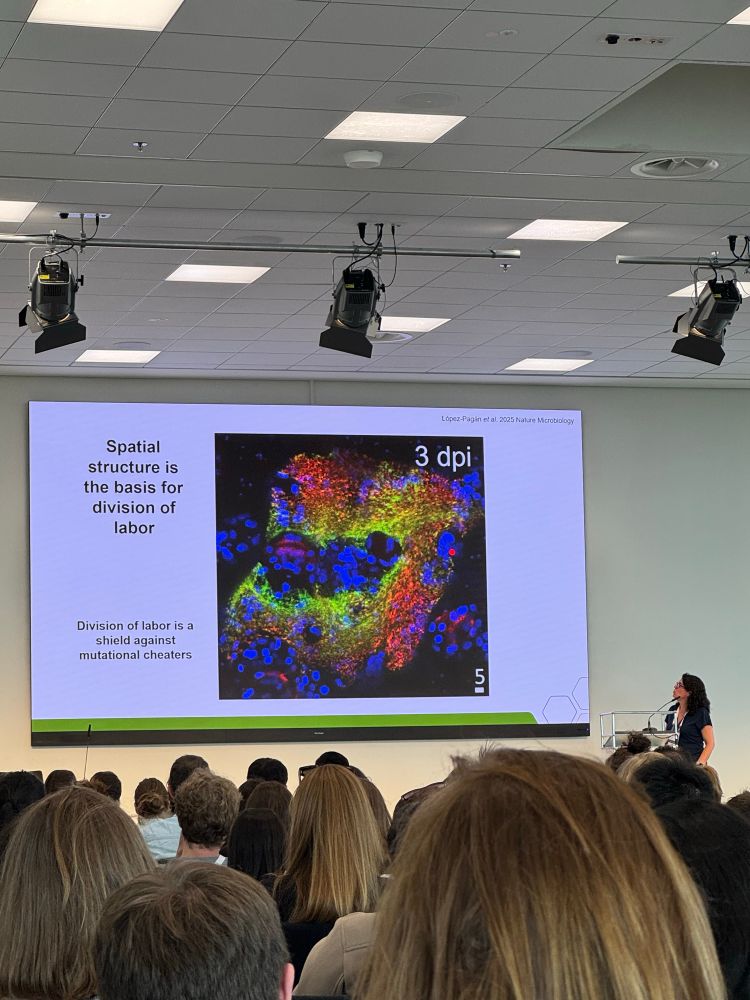
A woman giving a scientific talk with a PowerPoint slide showing a colorful micrograph and test indicating that spatial structure is the basis for division of labor
Absolutely gorgeous images showing expression reporters in Pseudomonas syringae from @type3lab.bsky.social - variety in flagella and type iii secretion system expression within a group of cells.
#2025ISMPMI
17.07.2025 14:23 — 👍 22 🔁 4 💬 3 📌 0
Please don't miss it! A great session on the spatial and temporal regulation of plant–microbe interactions, hosted by @uprogress.bsky.social and @tatsuyanobori.bsky.social Many attractive talks, including our latest research presented by @crbeuzon.bsky.social
#ISMPMI2025 #MicroSky #PlantScience
17.07.2025 08:18 — 👍 6 🔁 5 💬 1 📌 0

Infographic on the chemistry of a mojito. Some key chemical components of rum, mint, lime and brown sugar are detailed with chemical structures.
It's Friday and it's #NationalMojitoDay!
Here's some of the chemistry behind this refreshing minty cocktail 🍹 www.compoundchem.com/2020/07/10/m...
#ChemSky 🧪
11.07.2025 19:54 — 👍 69 🔁 22 💬 2 📌 2
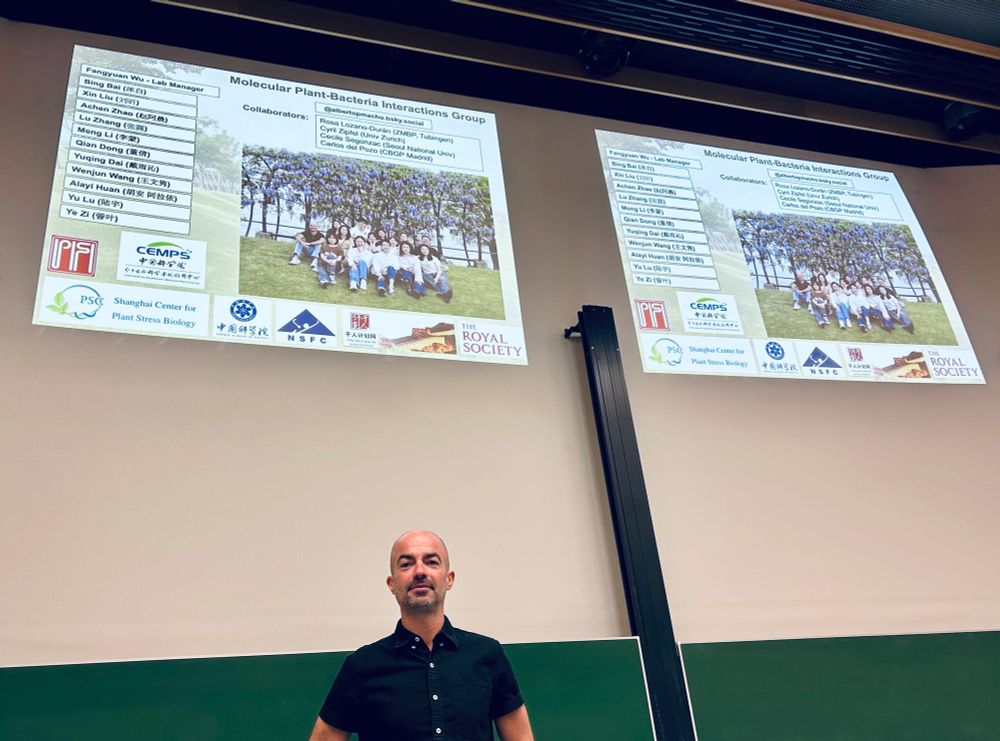
It was such a pleasure to host @albertopmacho.bsky.social at the @zmbp-tuebingen.bsky.social —in his little detour on his way to Cologne for the #2025ISMPMI. “Deciphering the interaction between plants and bacterial pathogens: beyond activation and suppression of immunity”—what a treat we got!
12.07.2025 12:24 — 👍 28 🔁 6 💬 1 📌 0
Happy and proud to participate in this collaboration between my home countries 🇪🇸🇨🇳
17.06.2025 11:51 — 👍 3 🔁 0 💬 0 📌 0
Microbiologist • Royal Society URF deciphering bacterial regulatory networks at @OxfordBiology • Nitrogen fixation • College advisor @KelloggOx • Volunteer at @ComunidadCERU 🍏🇪🇸🇬🇧
*Mum of three*
Postdoc @ Univ. of KS | NSF PRFB | KU Center for Genomics Fellow studying Plant-Microbe Interactions 🌽🥼🧪🦠
PhD, Purdue | BS, Nebraska - Lincoln
Chahta #NativeinSTEM | Sloan Indigenous Graduate Partnership
⚽️ 🍪 🎲 🎨
Postdoc in @geminiteamlab.bsky.social
(ZMBP Tübingen)🇩🇪←PhD, MSc@INRAE Avignon/Aix-Marseille U🇫🇷←BSc@Hokkaido U🇯🇵
Interested in plant virology/RNA/translation/viral symptoms/crop breeding 🌱🦠
Group leader at the Max Planck Institute for Biology in Tuebingen. Adaptive evolution of filamentous plant pathogens 🌾🍄🧬. Love nature and music 🎸🥁 dogfather 🐕
Postdoctoral researcherer at #TheUstunLab in @ruhr-uni-bochum.de working on P-bodies and bacterial pathogens.
🏳️🌈 he/him
Virology, evolution, genomics, systems biology, and computational biology. All at once.
Cluster of Excellence "GreenRobust: Understanding Robustness of Plant Systems from Molecules to Ecosystems" research initiative led by the Universities of Tübingen, Heidelberg, and Hohenheim.
Website: www.greenrobust.de
PhD in the @geminiteamlab.bsky.social ZMBP, Tübingen. Interested in virus-host interaction.
Plant signaling. EMBO Fellow at Zipfel’s group, University of Zurich.
Postdoc at Earlham Institute (Norwich, UK) | Sarah Guiziou’s Lab | Synthetic Biology for plant–microbe interactions 🌱🤝🧫
PhD Candidate at the University of British Columbia; exploring plant-microbiome interactions
Taiwan x Norwich, The Sainsbury Laboratory. Illustration works https://paiinthelab.blog/
Post-doctoral fellow at University of Lausanne (Geldner Laboratory). Investigating immune functions at cell-type-specific resolution.
🧪 Infographics exploring everyday chemistry
📅 #PeriodicGraphics in @cenmag.bsky.social
🥇 ACS 2025 Interpreting Chemistry for the Public award
🏆 ABSW 2018 Science Blog Award
🖊️ Posts by @andy.compoundchem.com
🌐 Website: compoundchem.com
Plant Immunologist x Machine Learning, occasional biochemist | 🌱-🧫 interactions | UC Berkeley Postdoc | 2 x USDA NIFA Fellow
Plant cells and development, Plant-microbe research, Phytophthora, oomycetes & symbiotic fungi, TAL effectors (TAL DNA binding code codiscoverer) and Coleoptera
Professor of Plant Molecular Biology at the University of Geneva interested in how plants detect, signal, and respond to environmental cues, with a main research focus on UV-B perception & signalling
https://www.ulm-lab.ch/
Moving from Sci-Fi to Science 🔬📚🪴🤿🏕️🇦🇷 🇮🇱
Post-doc at WeigelWorld 🇩🇪, Plants & microbes
Past: PhD at Beja Lab, Marine microbiology








